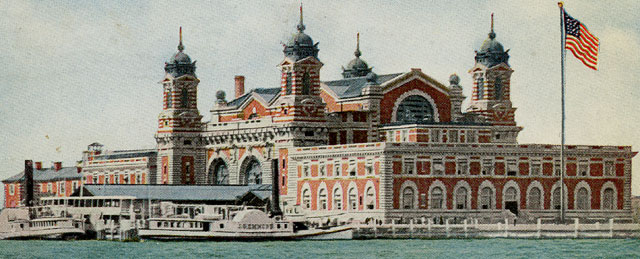
See also CHOLERA 1892

| |
| HOME - AZARIAN INTRODUCTION - BLANCK INTRODUCTION - GOEHLE INTRODUCTION - PETERMANN INTRODUCTION - LANGAN/WALSH INTRODUCTION - LAND INTRODUCTION - Irish Emigration - German Emigration | |
|
This page is an offshoot of IMMIGRATION See also CHOLERA 1892 | |
|
Quarantine By 1846 all vessels coming into the harbor were subject to quarantine inspection. Incoming ships were anchored near Staten Island. Passengers were examined and if found sick were sent to the quarantine hospital on Staten Island. If there were sick passengers onboard, the ship had to remain in quarantine for 30 days. It wasn't the most effective quarantine system in the world as two days a week visitors were allowed, and hundreds came by ferry from the city to Staten Island to visit. In 1847 there were 600 cases of small pox, 3,000 of typhus, and sixty cases of cholera at the quarantine hospital. As the population of Statin Island grew many people were unhappy about the closeness of the quarantine hospital. In 1857 and angry mob burned the facilities. "on the night of September 1 and 2, and destroyed all the buildings and other property, for which the county subsequently paid the State over one hundred thousand dollars, in accordance with the law making any county within which property is destroyed by a mob liable for the loss." (Harpers Weekly, September 6, 1879)A new locality was sought and various solutions were tried. In 1863 the General Quarantine Act was passed "defining the quarantine establishment, authorizing its construction, creating the permanent office of Quarantine Commissioner, defining the duties and powers of the Commissioners and Health Officer, and establishing a general system of quarantine for the port." (Harpers Weekly, September 6, 1879)Two islands were built with land fill in the Lower Bay - Swinburne Island in 1860 and Hoffman Island in 1873. Swinburne Island "encounters "the stead roll of the Atlantic," and the full force of the winds and storms. The row of long white hospital wards unmistakably indicates its character. Far away to the right, eight miles distant, at Seguine's Point, on the Staten Island shore, is the quarantine burying ground. Three miles and a half from Swinburne Island, in a nearly direct course toward Sandy Hook, is anchored, during the quarantine season, the hospital or boarding ship Illinois. Her great dismantled hulk can be seen for a long distance. The Boarding Officer for the lower bay resides upon this ship. All vessels arriving from the West Indies, South American ports, and from the west coast of Africa are required to come to anchor here while the Boarding Officer inspects them. All other vessels proceed up through the Narrows, and are boarded in the upper bay, opposite the Health Officer's residence, by the deputies, who are provided for this purpose with the steamer Governor Fenton.By 1900 The New York State Quarantine Station was examining an average of four to five hundred vessels a month. This required inspections of over four thousand immigrants in addition to the crews and passengers of ships not carrying immigrants. Not all ships were throughly inspected. Ships coming from non infected ports were boarded by the health inspectors. The ships doctor presented his report and all immigrants paraded in front of the heal officials with their heads uncovered. It was a quick check to see if there were obvious cases of such diseases as small pox. If there are any suspicious cases, they are further examined. The saloon passengers are not subjected to this inspection but are cleared on the word of the ship's doctor. "The difference in the treatment of saloon and steerage passengers is a measure due to the fact that infectious diseases are almost always transmitted by the latter class."Note: Infectious diseases are NOT class conscious. There were occasions when the ship's doctor was more that happy to cover up illness to accommodate important passengers on the ship who were anxious to return to business. Of course, a port could at any moment become infected. Consequently ships coming from the East and the Mediterranean would have been more susceptible to inspection. Naples, the major port of Italian immigration was known to have frequent cases of smallpox. Ships coming from "infected" ports were carefully inspected. If there are any question of illness on board the entire ship is held in Quarantine. In 1901 passengers where held a Hoffman island and the hospital and crematorium were on neighboring Swinburne Island. Today this islands are uninhabited and off limits to the general public. Bubonic plague, cholera, diphtheria, smallpox, typhoid fever, and yellow fever where the major diseases looked for by the health inspectors. In the summer of 1892 there was a cholera epidemic and several ships coming from Hanover Germany were kept in Quarantine. See Cholera 1892
|
 | |
| Leslie's History of Greater New York 1898 Quarantine, Hoffman Island, Lower Bay | |
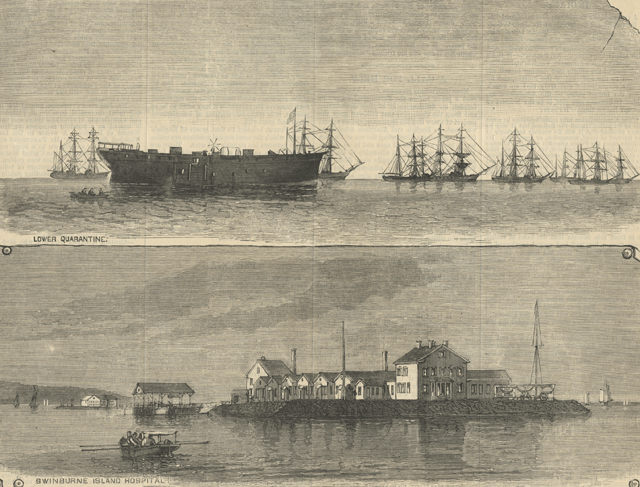 | |
| Harper's Weekly September 6, 1879, Collection of Maggie Land Blanck, 2011
LOWER QUARANTINE - Lower Quarantine was in the Lower Bay - between Statin Island and Coney Island. SWINBURNE ISLAND HOSPITAL - Swinburne Island, a man made island off the shore of Staten Island, is currently unused.
| |
 | |
| Harper's Weekly September 6, 1879, Collection of Maggie Land Blanck, 2011 UPPER QUARANTINE
| |
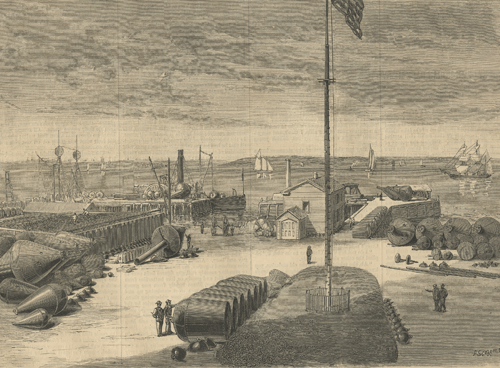 | |
| Harper's Weekly September 1879, Collection of Maggie Land Blanck, 2011 THE BUOY STATION, QUARANTINE LANDING STATEN ISLAND
| |
 | |
| Harper's Weekly, October 8, 1887,Collection of Maggie Land Blanck, 2011
| |
 | |
| Harper's Weekly, October 8, 1887,Collection of Maggie Land Blanck, 2011
| |
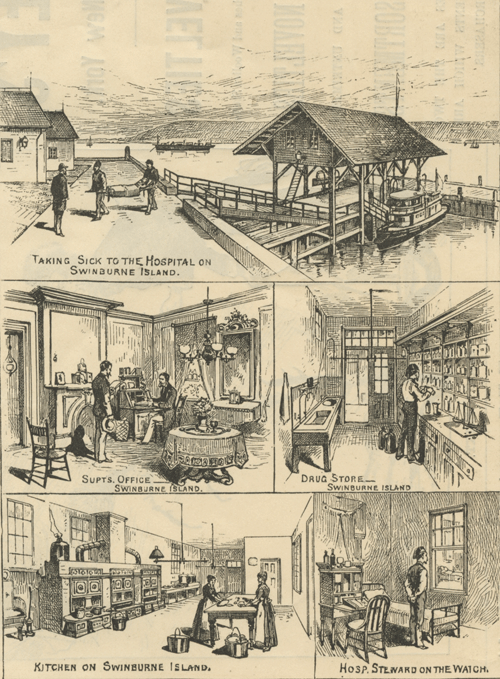 | |
| Harper's Weekly, October 8, 1887, Collection of Maggie Land Blanck, 2011
| |
 | |
| Harper's Weekly, October 8, 1887, Collection of Maggie Land Blanck, 2011
| |
 | |
| Harper's Weekly, October 8, 1887, Collection of Maggie Land Blanck, 2011
| |
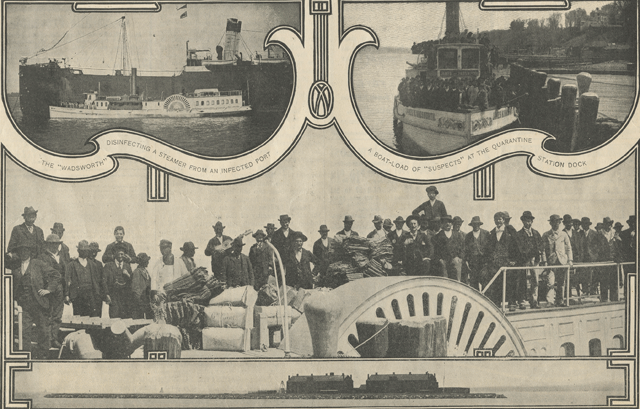 | |
| Collier's Weekly, June 22, 1901 EUROPEAN IMMIGRANTS LANDING AT THE HOFF MAN ISLAND WARF, THE ISLAND SHOWN IN THE BOTTOM PICTURE
| |
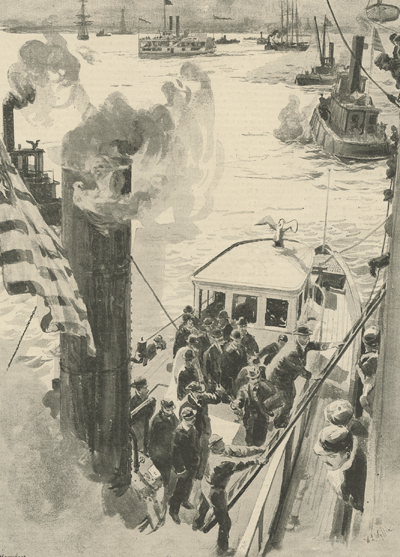 |
On the Quarantine Ground, New York Harbor;
Health-Offiers Coming on Board Drawn by W. L. Wyllie
|
| The Graphic June 10, 1893, collection of Maggie Land Blanck
| |
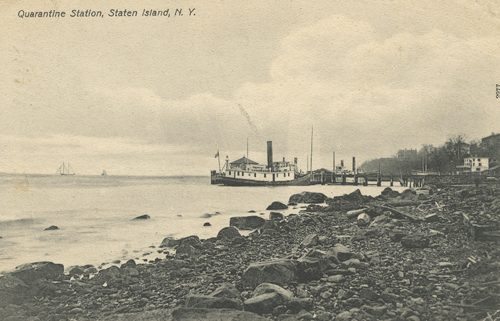 |
Quarantine Station, Staten Island, dated July 9, 1907
|
| Postcard collection of Maggie Land Blanck
| |
| In August to September 1892 there was a breakout of Cholera in ships
entering
New York Harbor from Hamburg, Germany. For more information on this outbreak and for more images of the
Quarantine Station go to Cholera Outbreak in New York Harbor
1892 now or at the bottom of the page.
| |
|
This page is an offshoot of IMMIGRATION See also, CHOLERA 1892 | |
| HOME - AZARIAN INTRODUCTION - BLANCK INTRODUCTION - GOEHLE INTRODUCTION - PETERMANN INTRODUCTION - LANGAN/WALSH INTRODUCTION - LAND INTRODUCTION - Irish Emigration - German Emigration |
| If you have any suggestions, corrections, information, copies of documents, or photos that you would like to share with this page, please contact me at maggie@maggieblanck.com |
| Please feel free to link to this web page. You may use images on this web page provided that you give proper acknowledgement to this web page and include the same acknowledgments that I have made to the provenance of the image. Please be judicious. Please don't use all the images. Please do not cut and paste the whole page. You may NOT make use any of the images or information on this web page for your personal profit. You may NOT claim any content of this web page as your original idea. Thanks, Maggie |
| This page was created in 2011 as an offshoot of a page created in 2004: Latest update, August 2019 |